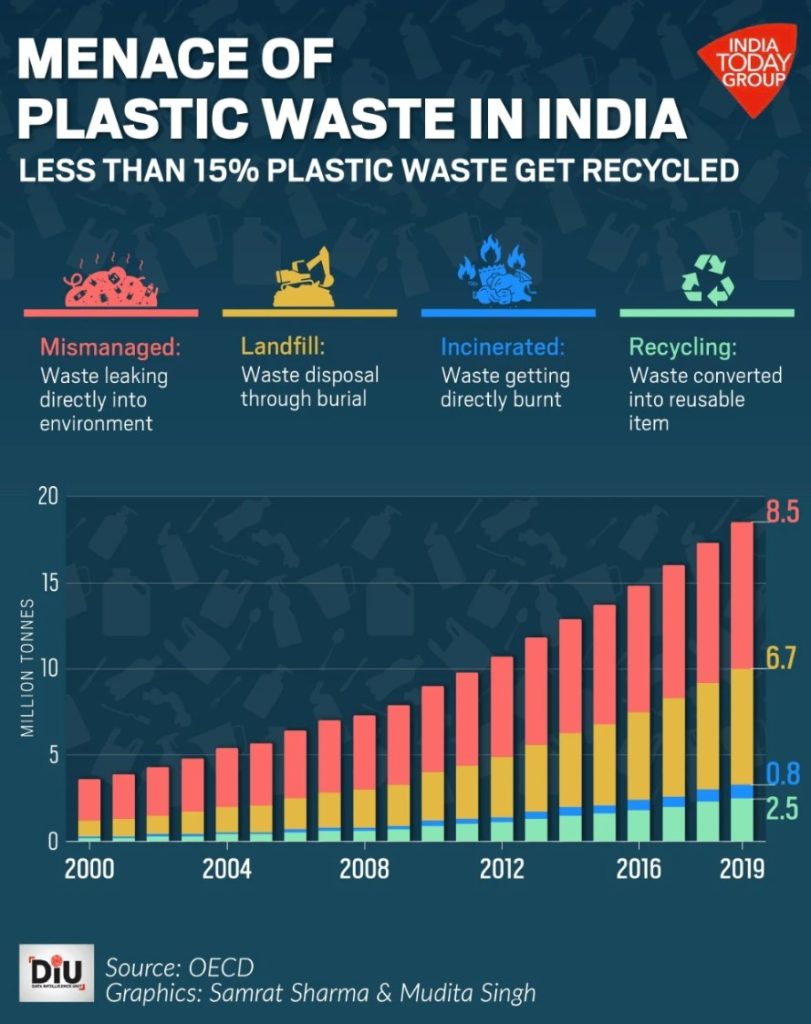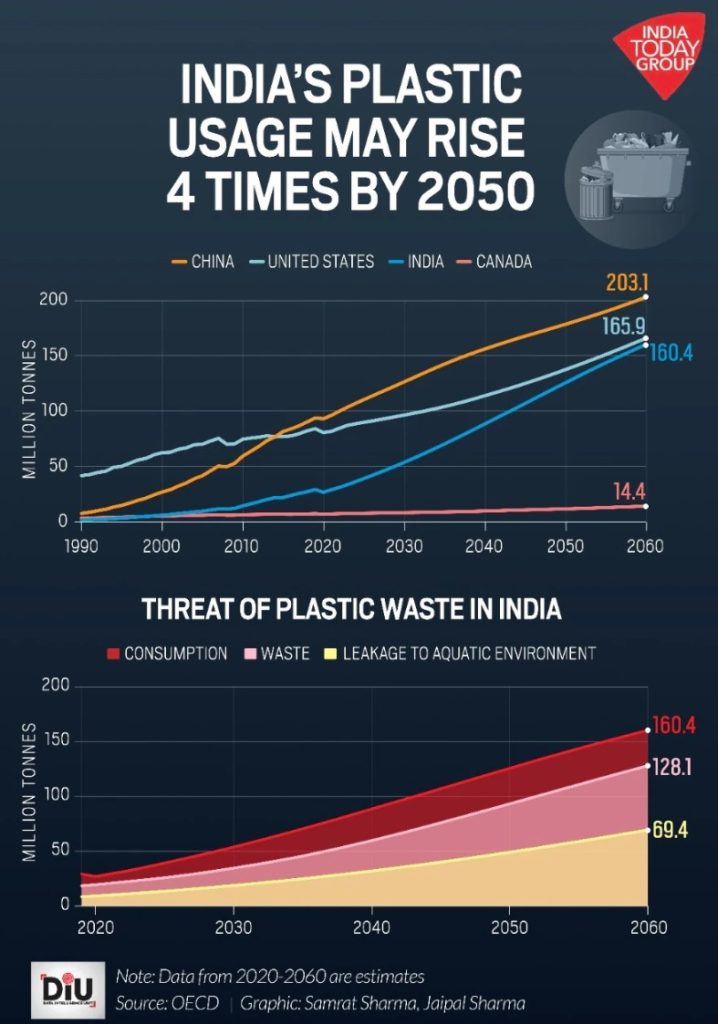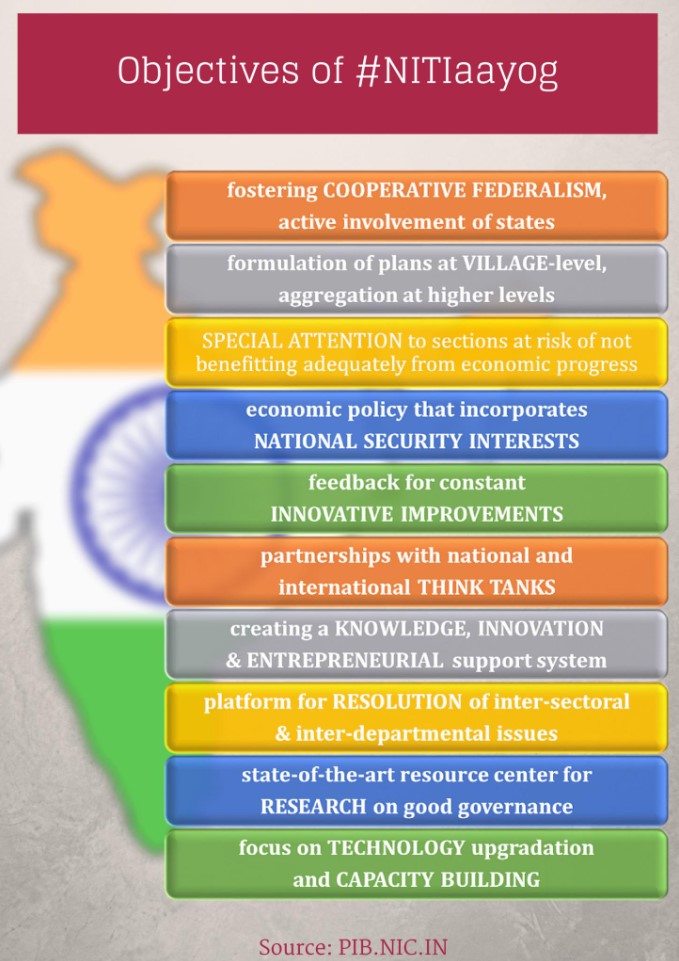CONTENTS
- India and the Plastic Waste Problem
- Structural and Functional Issues of the the NITI Aayog
India and the Plastic Waste Problem
Context:
India, like many large economies, grapples with a significant plastic waste issue. A 2020-21 report from the Central Pollution Control Board (CPCB) indicates that the country generates four million tonnes of plastic waste annually. Unfortunately, only about 25% of this waste is recycled or treated, with the remainder ending up in landfills or being disposed of unsustainably.
Relevance:
- GS2: Government Policies & Interventions
- GS3: Environmental Pollution & Degradation
Mains Question:
Discuss the procedure behind the functioning of Extended Producer Responsibility (EPR) rules under the Plastic Waste Management Rules 2016. How successful have EPR rules proved to be and what can be done to enhance their effectiveness? (15 Marks, 250 Words).
Relevant Statistics:
- According to UN data, over 400 million tonnes of plastic are produced globally each year, with half intended for single use. Less than 10% of this plastic is recycled.
- An estimated 19-23 million tonnes of plastic end up in lakes, rivers, and oceans annually.
- Worldwide, one million plastic bottles are purchased every minute, and up to five trillion plastic bags are used each year.
- Half of all produced plastic is designed for single-use, intended to be discarded after one use.


Objective of the Plastic Waste Management Rules 2016:
- Increase Thickness of Plastic Bags: Raise the minimum thickness of plastic carry bags from 40 to 50 microns and establish a minimum thickness of 50 microns for plastic sheets to aid in collection and recycling.
- Expand Applicability: Extend the rules from municipal to rural areas, acknowledging that plastic waste has spread to rural regions.
- Assign Responsibilities: Incorporate the responsibilities of producers and generators in the plastic waste management system.
- Implement Collect Back System: Introduce a system for producers and brand owners to reclaim plastic waste under the extended producer responsibility framework.
- Promote Alternative Uses: Encourage using plastic waste for road construction per Indian Road Congress guidelines, or for energy recovery, waste-to-oil conversion, and other methods.
Working of the Extended Producer Responsibility (EPR) Rules:
- Since 2016, the Plastic Waste Management Rules have mandated that plastic users collect and recycle their waste. These Extended Producer Responsibility (EPR) rules, initially voluntary, are now enforced through an online EPR trading platform.
- The EPR system involves packagers, importers, and major industrial users of plastic packaging, along with professional recyclers, registering with the CPCB. Recyclers, who have networks to gather plastic waste, recycle it and receive validated certificates for each tonne recycled.
- These certificates can be uploaded to a dedicated CPCB portal and purchased by plastic packaging companies that do not meet their annual recycling targets.
- In 2022-23, the CPCB estimated that certificates for nearly 3.7 million tonnes of recycled plastic were generated.
- However, approximately 600,000 of these certificates were fraudulent, and hackers reportedly stole several thousand certificates last year, selling them to companies.
- A criminal investigation is ongoing, and the true amount of the claimed 3.7 million tonnes genuinely recycled is unclear.
Actions Taken:
- In response, the CPCB has implemented two significant actions. First, it commissioned an audit of nearly 800 firms, representing almost a quarter of the 2,300 registered recyclers who had traded certificates.
- Second, it overhauled the security features on the EPR trading platform, although this has delayed the filing of returns for 2023-24 by several months.
Way Forward:
- The CPCB described these issues as “teething problems” with implementing a large-scale electronic system.
- While the audit is necessary, it should be a one-time initiative to maintain trust in the system without annual, lengthy investigations.
- Although the CPCB can impose heavy fines, the process is lengthy and fraught with legal challenges. A market-driven approach to addressing plastic waste has a significant but limited impact.
- More efforts are needed to reduce plastic production and promote sustainable alternatives.
Conclusion:
Addressing the root causes of plastic waste and improving recycling systems’ effectiveness are crucial for mitigating India’s plastic waste problem.
Structural and Functional Issues of the NITI Aayog
Context:
With representatives from ten States and Union Territories skipping the ninth Governing Council meeting of the NITI Aayog, chaired by the Indian Prime Minister, questions have arisen about the think tank’s role.
Relevance:
GS2-
- NITI Aayog
- Planning
- Co-operative Federalism
Mains Question:
What was the rationale behind the creation of NITI Aayog? Examine the structural and functional issues plaguing its performance. (10 Marks, 150 Words).
About NITI Aayog:
- Planning has been ingrained in the Indian mindset as leaders were influenced by the socialist atmosphere of the former USSR.
- For nearly six decades, the Planning Commission functioned as the vehicle for planning, using a control and command approach.
- On January 1, 2015, the Planning Commission was replaced by a new institution, NITI Aayog, emphasizing a ‘Bottom-Up’ approach to realize the vision of Maximum Governance, Minimum Government, reflecting the spirit of ‘Cooperative Federalism.’

What about the Composition of NITI Aayog?
- Chairperson: Prime Minister
- Vice-Chairperson: Appointed by the Prime Minister
- Governing Council: Includes Chief Ministers of all states and Lt. Governors of Union Territories.
- Regional Council: Addresses specific regional issues, comprising Chief Ministers and Lt. Governors, and is chaired by the Prime Minister or a nominee.
- Adhoc Membership: Two members in an ex-officio capacity from leading research institutions on a rotational basis.
- Ex-Officio Membership: Up to four from the Union Council of Ministers, nominated by the Prime Minister.
- Chief Executive Officer: Appointed by the Prime Minister for a fixed term, with the rank of Secretary to the Government of India.
- Special Invitees: Experts and specialists with domain knowledge, nominated by the Prime Minister.
What are NITI Aayog Hubs?
- Team India Hub: Acts as an interface between States and the Centre.
- Knowledge and Innovation Hub: Builds the think tank’s expertise of NITI Aayog.
The Aayog plans to produce three documents: a 3-year action agenda, a 7-year medium-term strategy paper, and a 15-year vision document.
Rising Dissatisfaction with the Think Tank’s Role:
- Seven of these representatives boycotted the meeting, including the Chief Ministers of Tamil Nadu, Kerala, Karnataka, Telangana, Punjab, Himachal Pradesh, and Jharkhand, due to concerns over the perceived lack of allocations and projects for their States in the Union Budget.
- The boycott, along with West Bengal Chief Minister Mamata Banerjee’s later walkout, indicates dissatisfaction with the think tank’s role as merely an advisory body to the Union Government.
- This discontent is mainly among leaders of the political opposition. Established by the NDA government during its first term to replace the Planning Commission, the NITI Aayog was intended to move away from the “top-down” approach and focus on “cooperative federalism.”
- However, by remaining an advisory body without power over resource distribution or allocation to States and focusing on creating indices to evaluate States, it has inadvertently led to “competitive federalism.”
- Meanwhile, the Finance Ministry retains unrestricted power over State grants. Unlike the Planning Commission, which faced its own criticism, at least it allowed for consultations with States on such matters.
Recent Developments:
- The situation hasn’t improved with the ruling party campaigning in State elections on the promise of “double engine” governments, leading to complaints from Opposition-ruled States that the Centre has favored some States for investment projects.
- The government’s reliance on the support of parties ruling Bihar and Andhra Pradesh—States facing various developmental deficits—and the Finance Minister’s clear intention to address their demands specifically in the Budget have not gone unnoticed by the government’s critics.
- Regardless of the validity of this argument, the fact remains that consultations with States on grants and projects have decreased since the Planning Commission was dissolved.
Conclusion:
While the 16th Finance Commission is responsible for addressing horizontal imbalances among States and the Finance Ministry focuses on macroeconomic stability and the financial system, there is a need for institutional support at the Centre to promote growth through infrastructure and capital investments in States. The NITI Aayog should be reimagined to restore some of the responsibilities the Planning Commission had for States to achieve genuine “cooperative federalism.“




